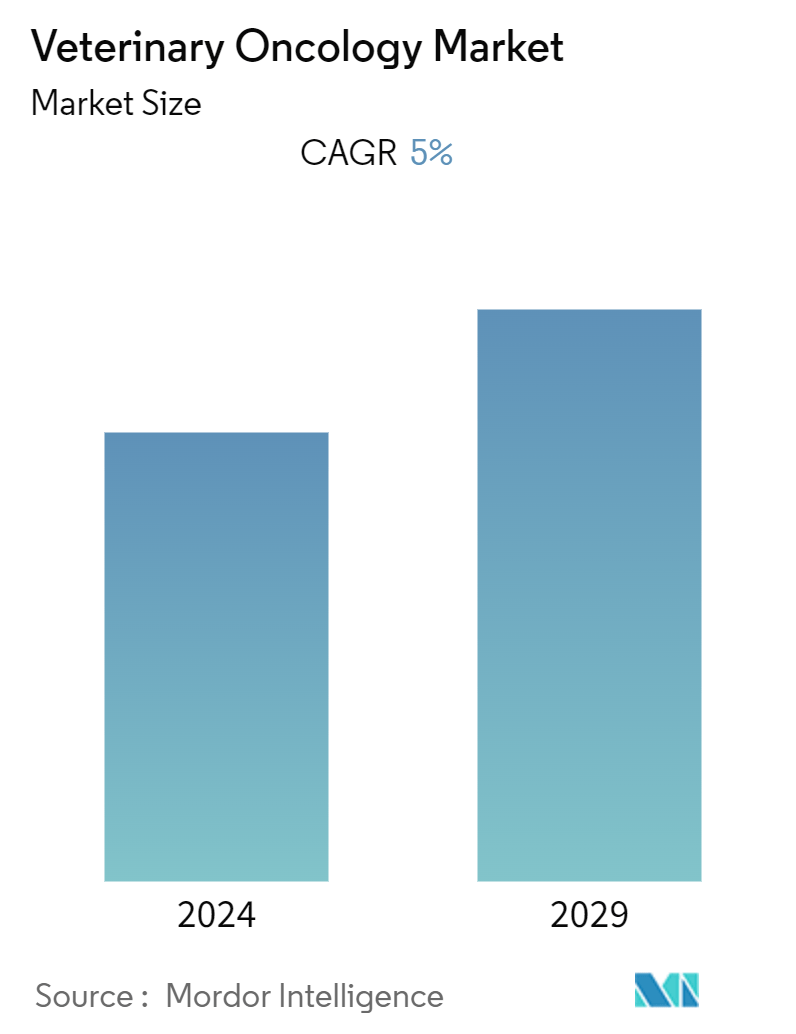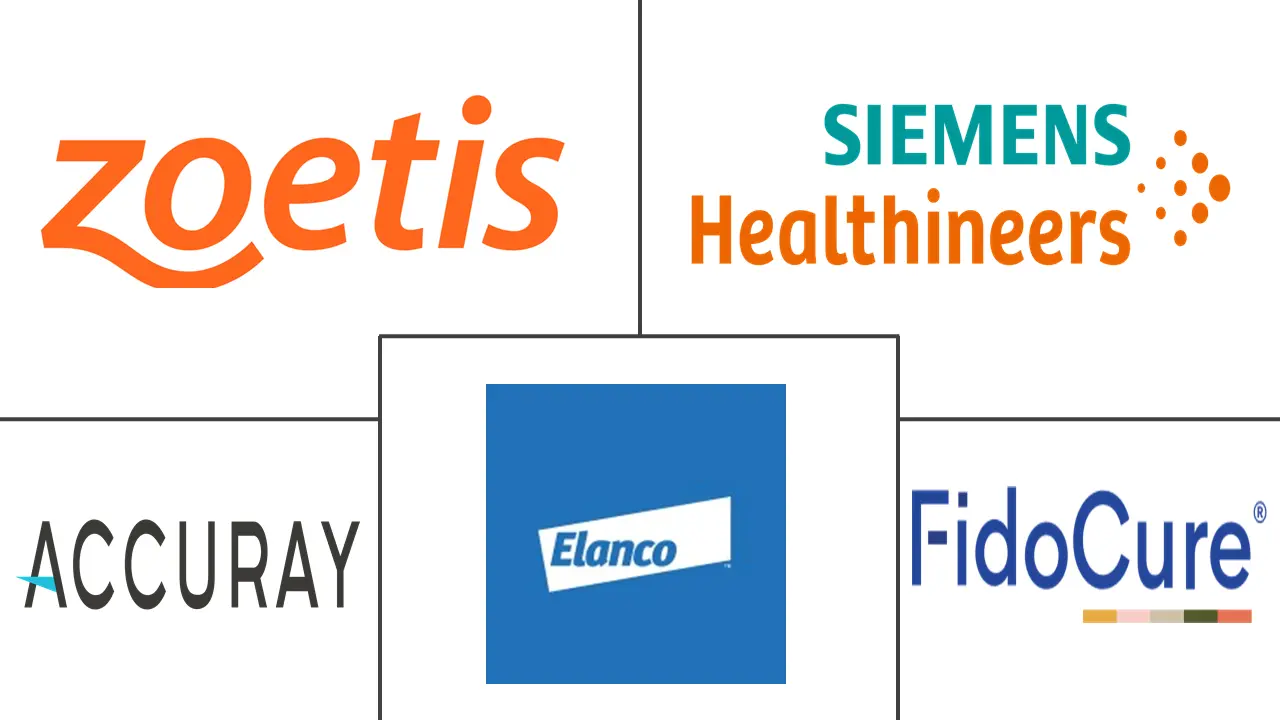Market Size of Veterinary Oncology Industry

| Study Period | 2019 - 2029 |
| Base Year For Estimation | 2023 |
| CAGR (2024 - 2029) | 5.00 % |
| Fastest Growing Market | Asia-Pacific |
| Largest Market | North America |
| Market Concentration | Low |
Major Players
*Disclaimer: Major Players sorted in no particular order |
Veterinary Oncology Market Analysis
The Veterinary Oncology Market is expected to register a CAGR of 5% during the forecast period.
Factors such as the rising prevalence of cancer in animals, increasing investments in research and development in the area of veterinary oncology, and growing veterinary healthcare expenditure are expected to drive market growth.
As the burden of cancer cases in animals increases, the demand for effective and advanced therapeutics for cancer treatment is also expected to rise, driving growth in the market studied. For instance, according to a research study published in Aging and Cancer in February 2022, it was estimated that one in four dogs would be diagnosed with cancer in their lifetime. Cancer is the leading cause of death in pets beyond middle age. Therefore, due to the high prevalence of cancer among animals such as dogs, the demand for therapeutics is expected to increase, driving growth in the market studied.
Moreover, the increasing veterinary healthcare expenditure, growing adoption of pet health insurance, and rising research and development activities for the development of effective therapeutics, coupled with new investments, are further expected to augment the growth of the veterinary oncology market during the forecast period. For instance, in January 2024, the Morris Animal Foundation unveiled its latest cohort of eight grant recipients. These researchers are poised to drive forward the Foundation's mission of enhancing the quality of life for canines battling cancer through innovative research endeavors.
The growing burden of cancer in pets is expected to increase demand for veterinary oncology drugs over the forecast period. For instance, according to Kansas City Veterinary Medical Association’s data in July 2022, purebred dogs were 1.9 times more likely to develop cancer than non-purebred dogs in 2022. Thus, the significant burden of cancer in dogs is expected to boost the market over the forecast period.
Moreover, strategic activities by market players, such as funding initiatives, are expected to contribute to market growth over the forecast period. For instance, in November 2022, UW School of Veterinary Medicine received a grant of USD 75,000 to offer life-saving cancer care to pets and their families. The grant was to be distributed on a first-come, first-served basis of up to USD 4,000 per client. Additionally, in May 2022, Jaguar Health launched the Canine Cancer: Take C.H.A.R.G.E. (Canine Health And Registry Exchange). It is a national canine cancer registry that aims to provide the veterinary community and dog owners with vital incidence and prevalence data to aid in the diagnosis and treatment decisions of canine cancer.
Thus, the growing burden of cancer in pets and strategic initiatives taken by the government and market players are expected to contribute to the segment’s growth over the forecast period. However, the high costs associated with cancer treatment and the lack of awareness about veterinary diseases among pet owners are factors that may restrain the growth of the veterinary oncology market during the forecast period.
Veterinary Oncology Industry Segmentation
As per the scope of the report, cancer therapies are drugs that block the growth and proliferation of cancer by interfering with specific molecules, such as DNA or proteins, which are involved in the growth or expansion of cancerous cells. These therapies include surgery, radiation therapy, chemotherapy, and immunotherapy. The report includes revenue for cancer therapies provided to animals.
The veterinary oncology market is segmented by treatment type, animal type, application, and geography. By treatment type, the market is segmented into radiotherapy, surgery, chemotherapy, and other treatment types. By animal type, the market is segmented into canine, feline, and other animal types. By application, the market is segmented into lymphoma cancer, mast cell cancer, mammary and squamous cell cancer, and other applications. By geography, the market is segmented into North America, Europe, Asia-Pacific, the Middle East and Africa, and South America. The report also covers the estimated market sizes and trends for 17 countries across major regions globally.
The report offers the market sizes and forecasts in value (USD) for the above segments.
| By Treatment Type | |
| Radiotherapy | |
| Surgery | |
| Chemotherapy | |
| Other Treatment Types |
| By Animal Type | |
| Canine | |
| Feline | |
| Other Animal Types |
| By Application | |
| Lymphoma Cancer | |
| Mast Cell Cancer | |
| Mammary and Squamous Cell Cancer | |
| Other Applications |
| Geography | ||||||||
| ||||||||
| ||||||||
| ||||||||
| ||||||||
|
Veterinary Oncology Market Size Summary
The veterinary oncology market is poised for significant growth, driven by the increasing prevalence of cancer in animals and rising veterinary healthcare expenditure. The market is expected to recover from the disruptions caused by the COVID-19 pandemic, which had impacted research and development activities and logistics for essential pharmaceutical products. Factors such as the growing demand for advanced cancer therapeutics, increased investment in research, and the adoption of pet health insurance are anticipated to propel market expansion. The canine segment is expected to dominate the market due to the high incidence of cancer in dogs, supported by longer lifespans and increased pet adoption rates. The introduction of new therapeutics and product approvals further bolsters this segment's growth.
North America is expected to maintain a significant share of the veterinary oncology market, attributed to a large pet population, high veterinary healthcare expenditure, and advanced veterinary care services. The United States, in particular, is poised to hold a substantial market share due to its high number of pets and significant spending on animal healthcare. The market is moderately fragmented, with key players like Elanco, Zoetis, and Siemens Healthineers actively developing and launching new products. Initiatives such as grants for cancer care and national cancer registries are also contributing to the market's growth trajectory, highlighting the increasing focus on veterinary oncology.
Veterinary Oncology Market Size - Table of Contents
-
1. MARKET DYNAMICS
-
1.1 Market Overview
-
1.2 Market Drivers
-
1.2.1 Rising Prevalence of Cancer Cases in Animals
-
1.2.2 Increasing Investments on Research and Development in the Area of Veterinary Oncology
-
-
1.3 Market Restraints
-
1.3.1 High Costs of Cancer Treatment and Procedures
-
1.3.2 Lack of Awareness About Veterinary Diseases Among Pet Owners
-
-
1.4 Porter's Five Forces Analysis
-
1.4.1 Threat of New Entrants
-
1.4.2 Bargaining Power of Buyers/Consumers
-
1.4.3 Bargaining Power of Suppliers
-
1.4.4 Threat of Substitute Products
-
1.4.5 Intensity of Competitive Rivalry
-
-
-
2. MARKET SEGMENTATION (Market Size by Value - USD)
-
2.1 By Treatment Type
-
2.1.1 Radiotherapy
-
2.1.2 Surgery
-
2.1.3 Chemotherapy
-
2.1.4 Other Treatment Types
-
-
2.2 By Animal Type
-
2.2.1 Canine
-
2.2.2 Feline
-
2.2.3 Other Animal Types
-
-
2.3 By Application
-
2.3.1 Lymphoma Cancer
-
2.3.2 Mast Cell Cancer
-
2.3.3 Mammary and Squamous Cell Cancer
-
2.3.4 Other Applications
-
-
2.4 Geography
-
2.4.1 North America
-
2.4.1.1 United States
-
2.4.1.2 Canada
-
2.4.1.3 Mexico
-
-
2.4.2 Europe
-
2.4.2.1 Germany
-
2.4.2.2 United Kingdom
-
2.4.2.3 France
-
2.4.2.4 Spain
-
2.4.2.5 Italy
-
2.4.2.6 Rest of Europe
-
-
2.4.3 Asia-Pacific
-
2.4.3.1 China
-
2.4.3.2 Japan
-
2.4.3.3 India
-
2.4.3.4 Australia
-
2.4.3.5 South Korea
-
2.4.3.6 Rest of Asia-Pacific
-
-
2.4.4 Middle East and Africa
-
2.4.4.1 GCC
-
2.4.4.2 South Africa
-
2.4.4.3 Rest of Middle East and Africa
-
-
2.4.5 South America
-
2.4.5.1 Brazil
-
2.4.5.2 Argentina
-
2.4.5.3 Rest of South America
-
-
-
Veterinary Oncology Market Size FAQs
What is the current Veterinary Oncology Market size?
The Veterinary Oncology Market is projected to register a CAGR of 5% during the forecast period (2024-2029)
Who are the key players in Veterinary Oncology Market?
Elanco, Zoetis, Siemens Healthineers (Varian Medical Systems), Accuray Incorporated and OHC (One Health Company) are the major companies operating in the Veterinary Oncology Market.

